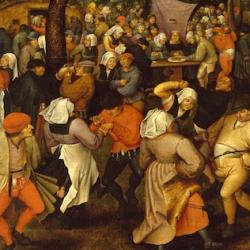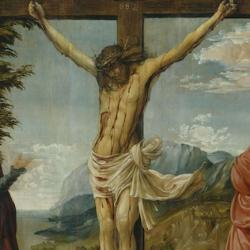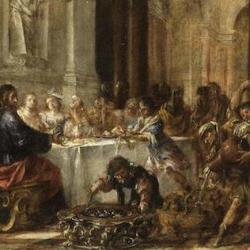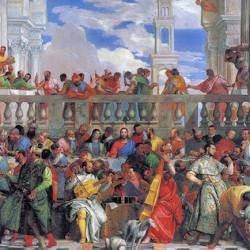Seven times in John’s Gospel, Jesus says “I am” with a predicate:
1)I am the bread of life, 6:35
2) I am the light of the world, 8:12
3) I am the door of the sheep, 10:7
4) I am the good shepherd, 10:14
5) I am the resurrection and the life, 11:25
6) I am the way, the truth, and the life, 14:6
7) I am the true vine, 15:1
Seven! And in John’s Gospel, the Gospel that begins with “In the beginning,” that talks about the Word as light, that traces seven days up to the Sabbath of the wedding of Cana.
But the I am statements frustrate our hopes. There are tantalizing hints: Jesus as light – but in the second slot, not the first. Jesus as fruit-bearing vine, but in the seventh rather than the third position, where it belongs.
Chiastic analysis yields some fruit. Bread and vine match; light (#2) can be stretched to link with Jesus as the way – He is the lighted way, the Way that is also light. As the door (#3), He is the one who opens to admit sheep to resurrection (#5). Jesus the good shepherd stands at the center.
But if we assume that John has the creation week in view, some interesting possibilities emerge. The whole list is framed by creations of Day 3, bread made from the grasses and the vine. Everything about which Jesus can say “I am” is enclosed by Day 3. He is light, a door, a shepherd, life and the way: But it all is tucked within the creation of Day 3. The whole of the seven is embraced by the third.
In John’s Gospel, two events happen “after two days” – Jesus’ departure from Samaria to Galilee (4:40, 43) and Jesus’ journey to Bethany where He raises Lazarus (11:6). The second is most relevant: Jesus arrives in Bethany on the third day to raise Lazarus. As in the other Gospels, resurrection is associated with the third day, which is also the eighth day, the day after the Sabbath.
Rising on the third day, Jesus is the firstfruits from the grave, as grain and fruit trees were the firstfruits from the earth on Day 3 of creation. Rising on the third day, Jesus is the bread of life, and the vine who provides life to the branches who abide in Him.
All other gifts are wrapped up within these third-day gifts. Precisely as risen bread-vine, Jesus is light, the door, the shepherd, resurrection life, the way and the truth. Precisely because of what “I am” on the third day, Jesus is “I am” in toto.
The Eucharistic overtones of Day 3 are clear, and that lends a Eucharistic frame to the “I am” statements. Jesus, risen on the third day, offers Himself as bread and the fruit of the vine. In receiving Him as the bread of life and abiding in Him as the vine, we are illumined by His light, enter the door into the fold, receive the care of the good Shepherd, partake of resurrection life, remain in the way of truth. Jesus gives Himself wholly when He gives Himself as bread and vine.
John’s list of “I am” statements remains within the confines of Day 3, but there’s a sequence. The list moves from bread to vine, from Alpha to Omega, from protology to eschatology. We can reason thus: The gifts of the third day are the gifts of beginning and end, the gifts of youth and age, of childhood and maturity.
But this highlights another apparent anomaly. Eucharist is bread and wine, not bread and vine. In Jesus’ I am statements, He is the trunk, the disciples the fruitful branches.
Jesus gives Himself to us as food, as bread. We abide in Him and He is us. And thus we are branches in the Vine, branches prepared to yield the wine of joy. In the sequence, Jesus is the beginning, but the disciples are the end; or, better, Jesus is the beginning and Jesus-with-branches is the end.
Jesus’ third day isn’t complete without us, without abiding branches. Jesus’ third day isn’t complete until the fruit we bear is crushed to make the blood of the grape, the wine of joy.












